Artist: Jonathan Fisher (1740-1809), painter and engraver, was born in Dublin.
Sepia Aquatint
c. 27 x 37 cm
Framed: 42 x 52.5 cm
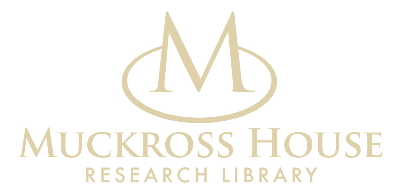

Artist: Jonathan Fisher (1740-1809), painter and engraver, was born in Dublin.
Sepia Aquatint
c. 27 x 37 cm
Framed: 42 x 52.5 cm

Artist: Sir William Orpen.(1878-1913). Orpen, a child prodigy, was born in Dublin in 1878 and died in London in 1931. This is a facsimile of the original.
c. 60 x 51 cm
Framed : c. 87 x 76 cm
In 1995 Mr Arthur W. B. Vincent presented the original of this painting of his grandmother as a gift to his grandparents’ former residence ‘Filoli’, California, USA. ‘Filoli now belongs to the National Trust for Historic Preservation.
Mrs Bowers Bourn was Agnes Moody of New York. A portrait of her husband, William Bowers Bourn, hangs on the facing wall.

Full Title: ‘XIIIth View of Killarney. Slat (sic) House at Derrycunahy, the Cascade in the Distance.’
Artist: Jonathan Fisher.
Sepia Aquatint
c. 27 x 37 cm
Framed: 42 x 52.5 cm

Full Title: ‘A View of the Lake of Killarney taken from Lord Kenmare’s Demesne by Major C.R. O’Donnell 16th Hussars.’ 18th Century.
Engraving
c. 17 x 117 cm
Framed: 24 x 124 cm

‘A View of the Lake of Killarney from the Park of the Right Honourable Lord Viscount Kenmare.’
Artist: Jonathan Fisher (1740-1809), painter and engraver, was born in Dublin. In 1770 Fisher published six large Views of Killarney, of which this is one. The views were engraved from pictures Fisher had painted of works by various London-based artists. This engraving is by T. Vivares.
Engraving
c. 40 x 53 cm
Framed: 55 x 67 cm

Full Title: ‘XIth View of Killarney, Eskanamucky Cascade, the Lower Range, with the Canal to Coleman’s Eye.’
Artist: Jonathan Fisher (1740-1809), painter and engraver, was born in Dublin.
Sepia Aquatint
c. 27 x 37 cm
Framed: c. 42 x 52.5 cm

Artist: Jonathan Fisher (1740-1809), painter and engraver, was born in Dublin.
Sepia Aquatint
c. 27 x 37 cm
Framed: 42 x 52.5 cm
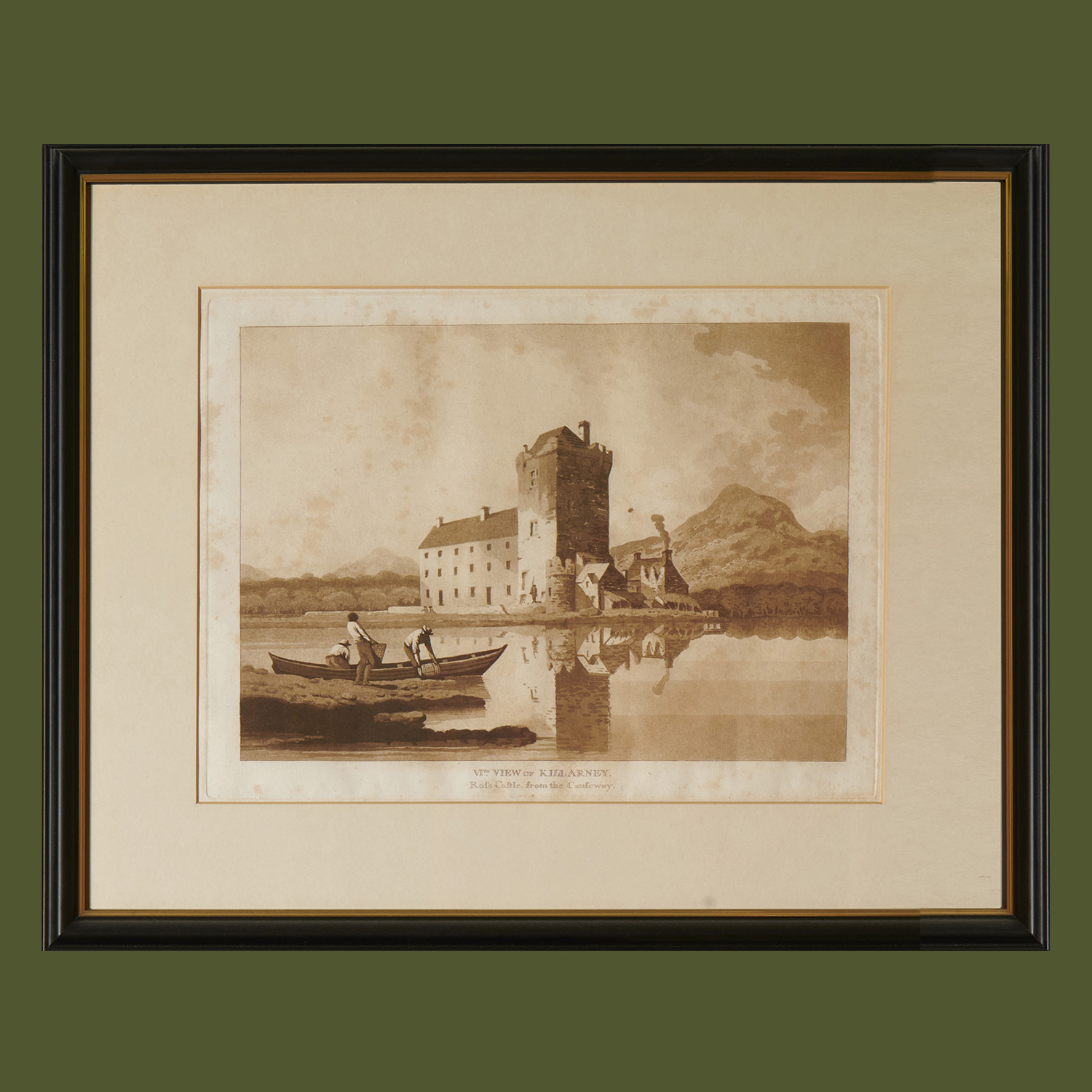
Artist: Jonathan Fisher (1740-1809), painter and engraver, was born in Dublin.
Sepia Aquatint
c. 27 x 37 cm
Framed: c. 42 x 52.5 cm

Full Title: ‘XIXth View of Killarney. Ross Castle from a point of (sic) Ross Island.’
Artist: Jonathan Fisher (1740-1809), painter and engraver, was born in Dublin.
Sepia Aquatint
c. 27 x 37 cm
Framed: c. 42 x 52.5 cm

Full Title: ‘IVth View of Killarney. Turk Lake, Mucruss Peninsula and the Lower Lake.’
Artist: Jonathan Fisher (1740-1809), painter and engraver, was born in Dublin.
Sepia Aquatint
c. 27 x 37 cm
Framed: 42 x 52.5 cm

Full Title: ‘A View of the Lake (sic) Killarney from near Dunlow (sic) Castle.’ Dated May 1770.
Artist: Jonathan Fisher (1740-1809), painter and engraver, was born in Dublin. In 1770 Fisher published six large Views of Killarney, of which this is one. The views were engraved from pictures Fisher had painted of works by various London-based artists. This engraving is by T. Mason.
Engraving
c. 39 x 52 cm
Framed: c. 53.5 x 66.5 cm

Depicts the Black Rock, Dublin and surrounding areas including Dunlary Town (Dún Laoghaire), Bray Head, Dublin Bay, Sugar Loaf Mountain, etc.
Artist: Artist: original painted by William Jones of Dublin, in 1744. This engraving of the original is by Giles Jones and also dated 1744.
Engraving
c. 37 x 46.5 cm
Framed: c. 51 x 60 cm

Artist: Jonathan Fisher (1740-1809), painter and engraver, was born in Dublin.
Sepia Aquatint
c. 27 x 37 cm
Framed: c. 42 x 52.5 cm

‘A View of the Eagles Nest on the Canal, between the Lakes of Killarney, Remarkable for the Wonderful Echoes from the Firing of Canon, etc.’
Artist: Jonathan Fisher (1740-1809), painter and engraver, was born in Dublin. In 1770 Fisher published six large Views of Killarney, of which this is one. The views were engraved from pictures Fisher had painted of works by various London-based artists. This engraving is by E. Rooker.
Engraving
c. 39 x 53 cm
Framed: c. 53 x 66 cm

Artist: Jonathan Fisher (1740-1809), painter and engraver, was born in Dublin.
Sepia Aquatint
c. 27 x 37 cm
Framed: c. 42 x 52.5 cm

Artist: Jonathan Fisher (1740-1809), painter and engraver, was born in Dublin.
Sepia Aquatint
c. 27 x 37 cm
Framed: 42 x 52.5 cm

Depicts Howth and surrounding areas including Ringsend, South Wall, Clontarf, Pool Beg, etc.
Artist: original painted by William Jones of Dublin, in 1745. This engraving of the original is by Giles Jones and also dated 1745.
Engraving
c. 37 x 46.5 cm
Framed: c. 50.5 x 61 cm

Artist: Jonathan Fisher (1740-1809), painter and engraver, was born in Dublin.
Sepia Aquatint
c. 27 x 37 cm
Framed: 42 x 52.5 cm

Full Title: ‘XVth View of Killarney. Old Smelting House at Derrycunahy, the Purple Mountain in the Distance.’
Artist: Jonathan Fisher (1740-1809), painter and engraver, was born in Dublin.
Sepia Aquatint
c. 27 x 37 cm
Framed: 42 x 52.5 cm
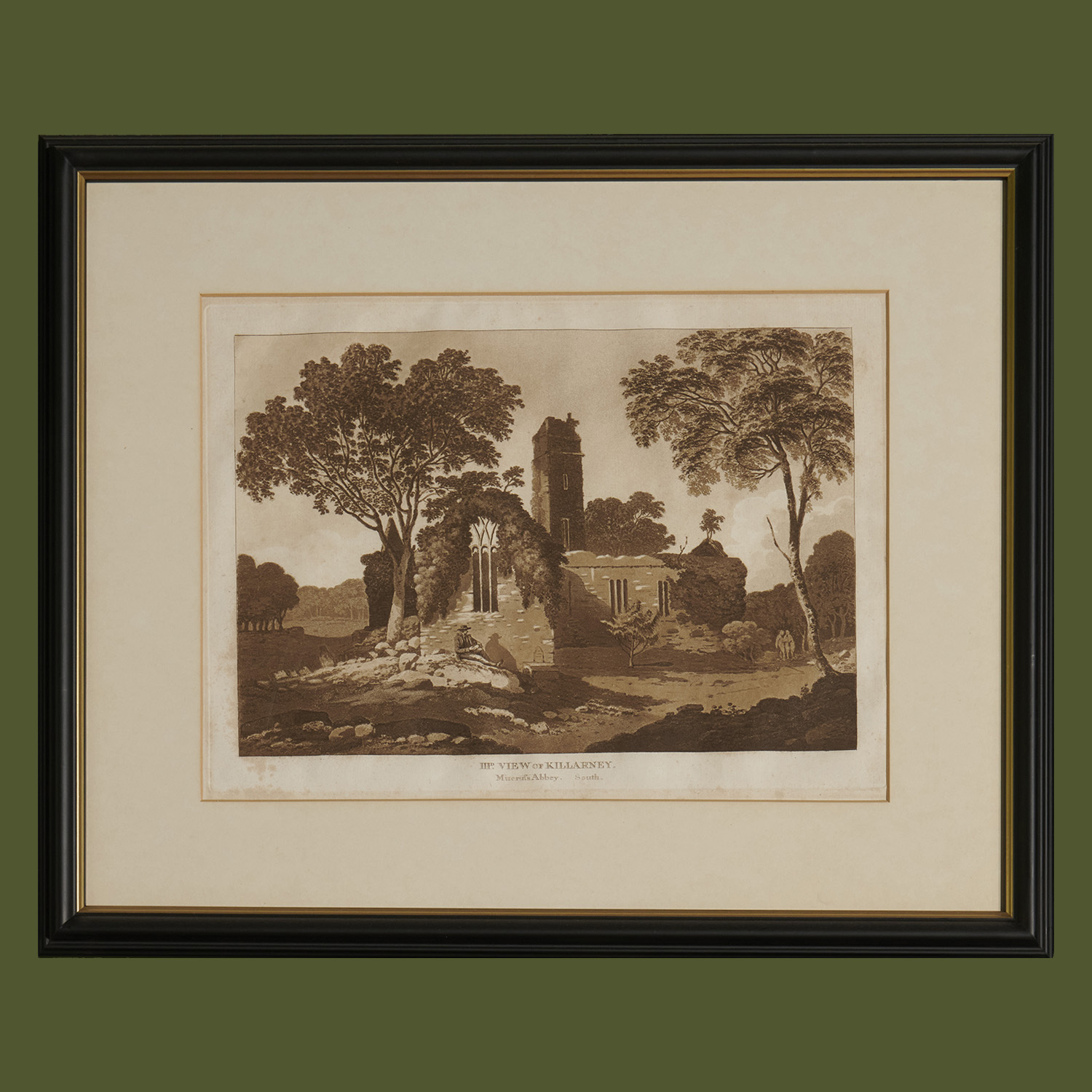
Artist: Jonathan Fisher (1740-1809), painter and engraver, was born in Dublin.
Sepia Aquatint
c. 27 x 37 cm
Framed: 42 x 52.5 cm

Artist: Jonathan Fisher (1740-1809), painter and engraver, was born in Dublin.
Sepia Aquatint
c. 27 x 37 cm
Framed: 42 x 52.5 cm

Full Title: ‘A View of O’Sullivan’s Cascade, which falls between the Mountains of Glena & Toomish into the Lake of Killarney.’
Artist: Jonathan Fisher (1740-1809), painter and engraver, was born in Dublin. In 1770 Fisher published six large Views of Killarney, of which this is one. The views were engraved from pictures Fisher had painted of works by various London-based artists. This engraving is by V. Picot.
Engraving
c. 39 x 53 cm
Frames: c. 53.5 x 67 cm

Full Title: A View of the Upper Lake of Killarney from Part of Turk Mountain.’
Artist: Jonathan Fisher (1740-1809), painter and engraver, was born in Dublin. In 1770 Fisher published six large Views of Killarney, of which this is one. The views were engraved from pictures Fisher had painted of works by various London-based artists. This engraving is by P. Mazell.
Engraving
c. 39 x 52 cm
Framed: c. 53.5 x 66.5 cm

Full Title: ‘XVIth View of Killarney. Ronayne’s Island, in the Upper Lake.’
Artist: Jonathan Fisher (1740-1809), painter and engraver, was born in Dublin.
Sepia Aquatint
c. 27 x 37 cm
Framed: 42 x 52.5 cm

Full Title: ‘IXth View of Killarney. Glena Mountain, from the SE. of the Old Weir Bridge.’
Artist: Jonathan Fisher (1740-1809), painter and engraver, was born in Dublin.
Sepia Aquatint c. 27 x 37 cm
Framed: 42 x 52.5 cm

Portrait of Arthur Rose Vincent (1876-1956), husband of Maud Bowers Bourn.
Artist: Signed and dated John L. Sargent, 1915
Charcoal drawing. This is a photographic reproduction of the origin
c. 58 x 44 cm
Framed: c. 84.5 x 60.5 cm

Full Title: ‘A View of the Canal between the Lakes of Killarney, from near Coleman’s Eye the Entrance to the Upper Lake.’ Dated May 1770.
Artist: Jonathan Fisher (1740-1809), painter and engraver, was born in Dublin. In 1770 Fisher published six large Views of Killarney, of which this is one. The views were engraved from pictures Fisher had painted of works by various London-based artists. This engraving is by P.C. Canot.
Engraving
c. 54 x 66.5 cm
Framed: c. 40 x 52 cm

Artist: Jonathan Fisher (1740-1809), painter and engraver, was born in Dublin.
Sepia Aquatint
c. 27 x 37 cm
Framed: c. 42 x 52.5 cm
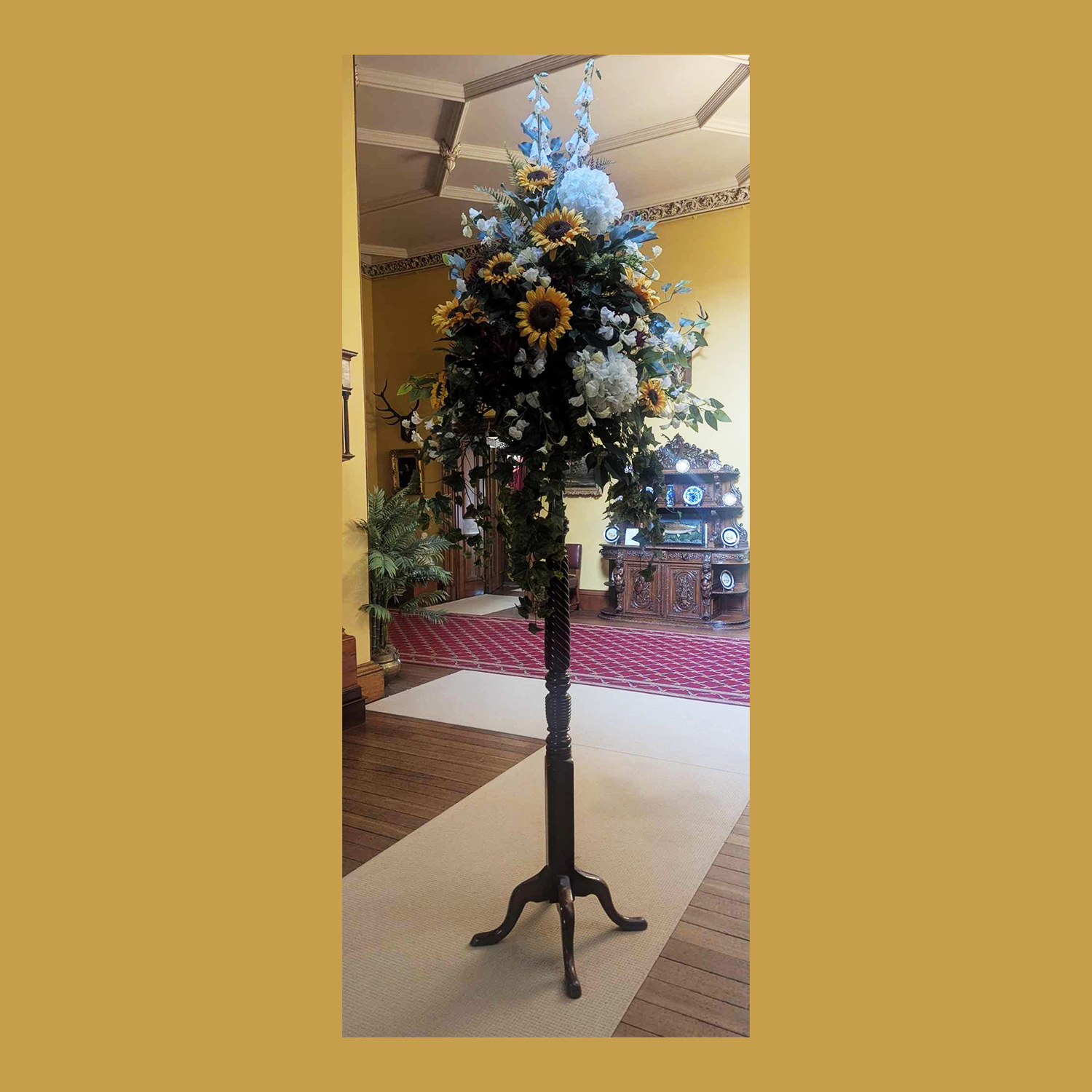
Mahogany plant stand, with spiral turned carving on the stem and a quadruped base.
Victorian in date.

A stained timber plant stand is located to either side of the Library door. The legs are fashioned to resemble elephant trunks and the ‘tusks’ are of bone. Probably late Victorian (c. 1870-1901) or early 20th century in date.
This pair of plant stands were acquired locally during the 1980s to reflect the Bourn Vincent ownership period (1911-1932).
Prior to his marriage in 1910 Arthur Rose Vincent, husband of Maud Bowers Bourn, was employed in the judicial service of the British Foreign Office. Among the places where he served were: East Africia, Siam (Thailand), China and Korea.

Corner cabinet of stained oak, probably mid-Victorian (c. 1850-1870) in date.
The figures attached at corners may have been repurposed and are possibly older than the cabinet itself.
The iconography on the two front panels may have some religious significance.
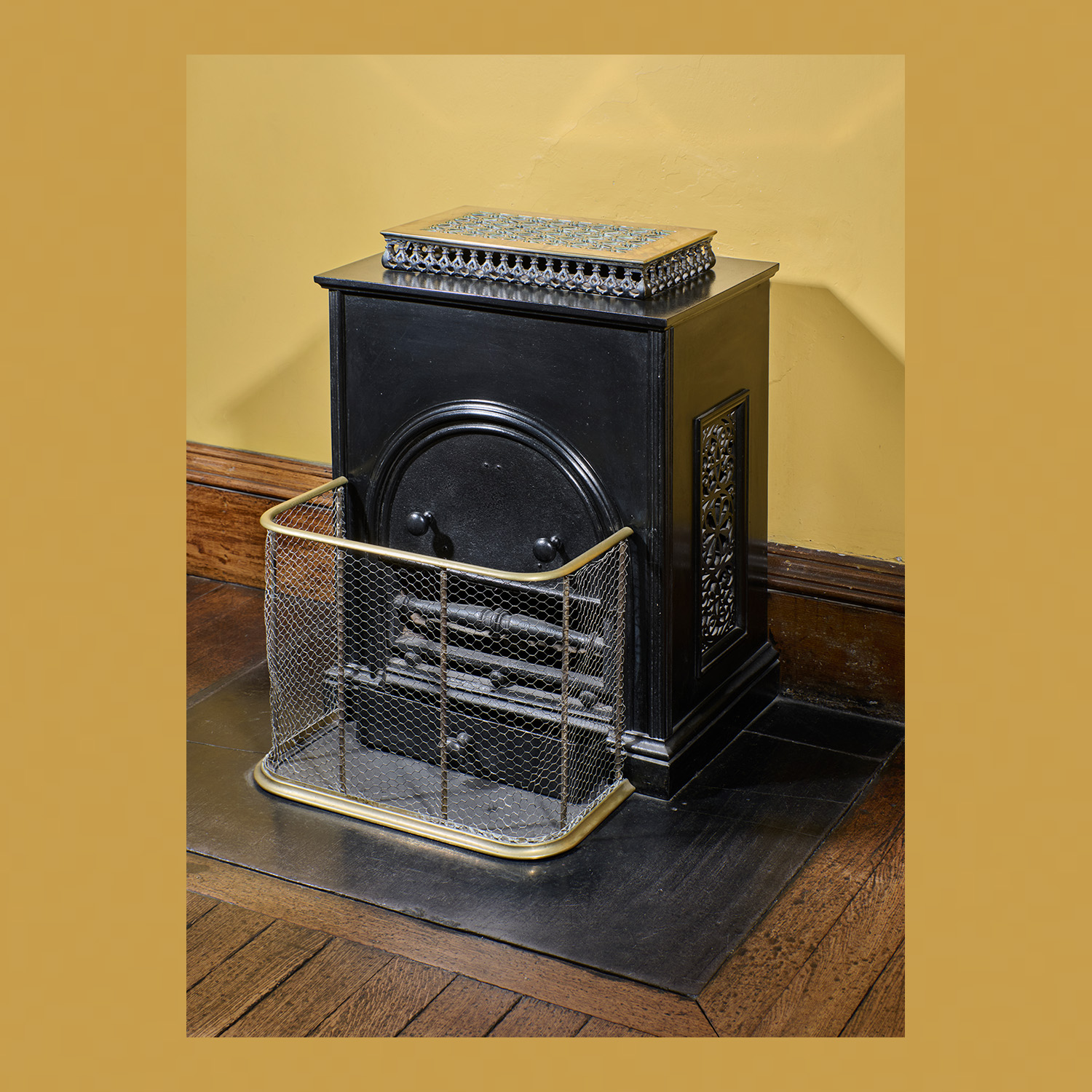
Located outside the Billiard Room, this stove provided heat to the Main Hall, which was often the location for social gatherings. Visitors could keep their drinks warm by standing them upon the brass plate.
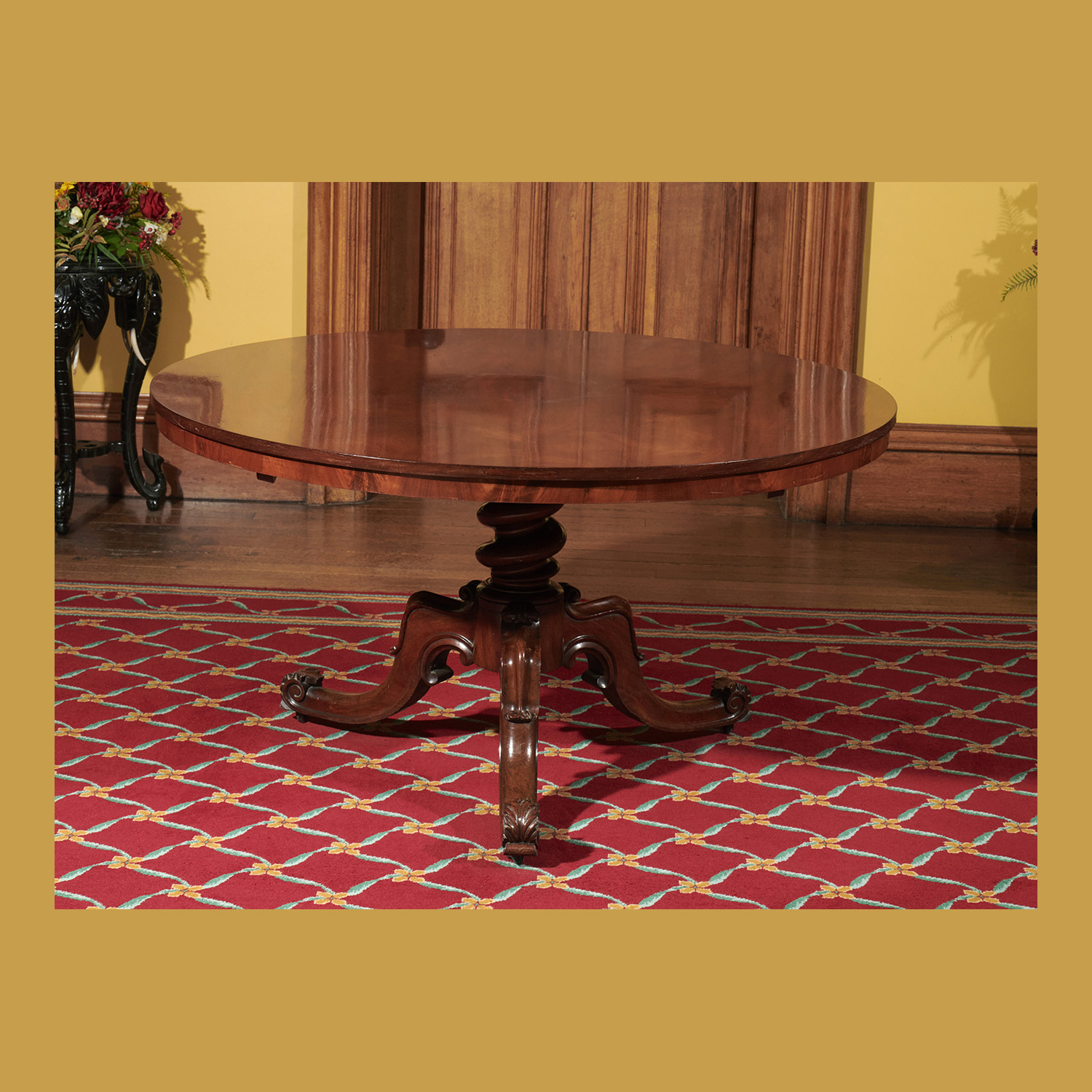
Mahogany and rosewood breakfast table, on central spiral tripod column, with floral carved decorations and castors. Probably 19th century in date.
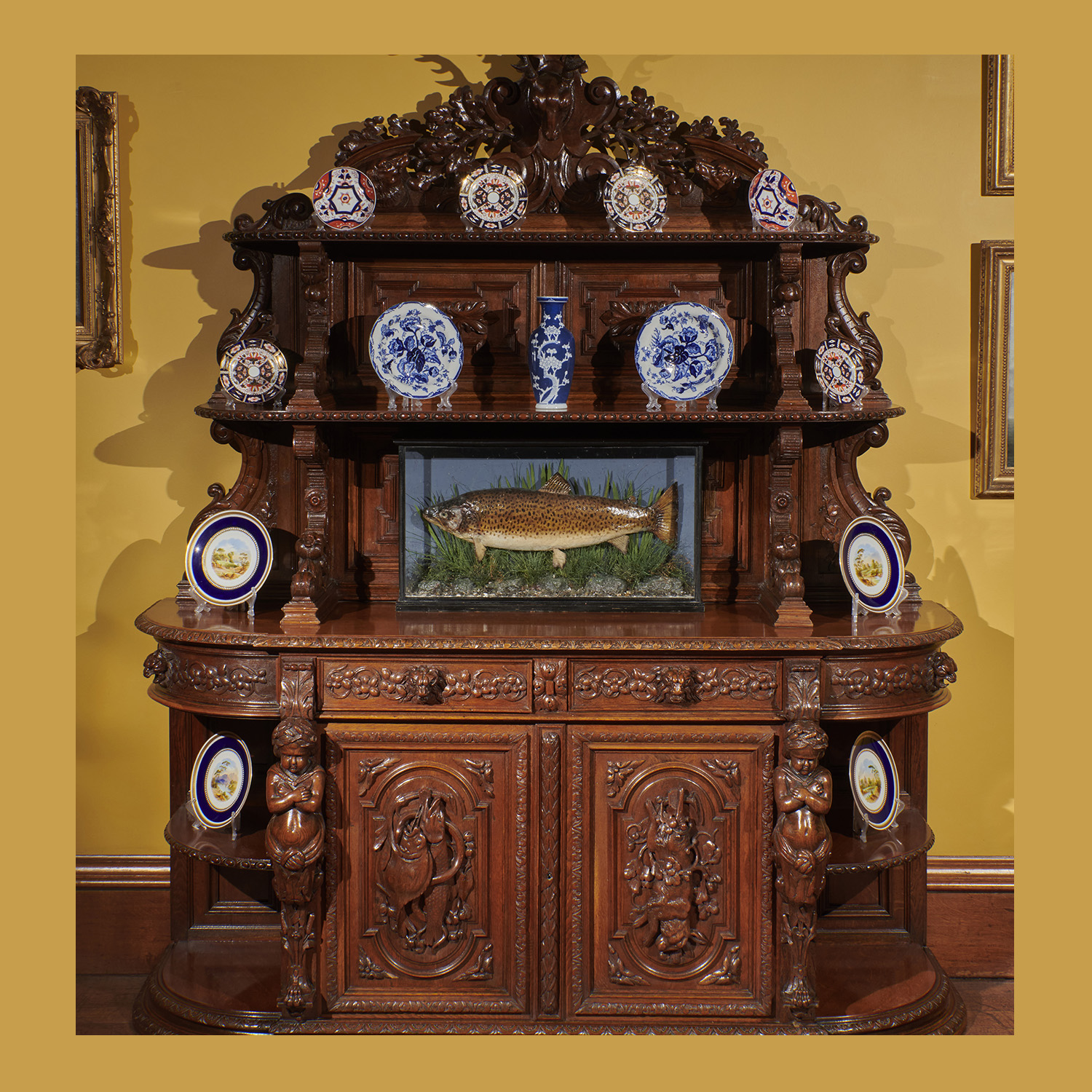
The richly carved deer, hounds, fish and hare on the sideboards standing either side of the central Library door reflect the hunting pastimes of Victorian gentlemen. Probably c. 1860 in date.
The brown trout displayed on all three sideboards in the Main Hall weigh between 6 and 7 kilograms (14 and 16 lbs). They were caught in the Lakes of Killarney by Mr Arthur Rose Vincent.

This marble statue of Arthur Edward Guinness, Lord Ardilaun, is by the Dublin-born sculptor Thomas Farrell (c. 1827-1900).
Measuring 68 cm (H) x 62 cm (W) x 38 cm (D), the statue dates to 1892. It is said to be a copy of the large bronze statue of Lord Ardilaun, which is located on the west side of St Stephen’s Green, Dublin. The latter is also by Farrell.
Lord Ardilaun purchased Muckross House and its Estate in November 1899. He was related by marriage to the Herbert family of Muckross.
Ardilaun’s wife Olivia was a daughter of Jane, Countess of Bantry. Jane was the youngest sister of Colonel Henry Arthur Herbert, the man responsible for building the present Muckross House.
The Ardilauns spent very little time at Muckross and it was let out on an annual basis as a shooting and fishing lodge. In 1911 Lord Ardilaun sold Muckross House and its Estate to the wealthy American William Bowers Bourn.
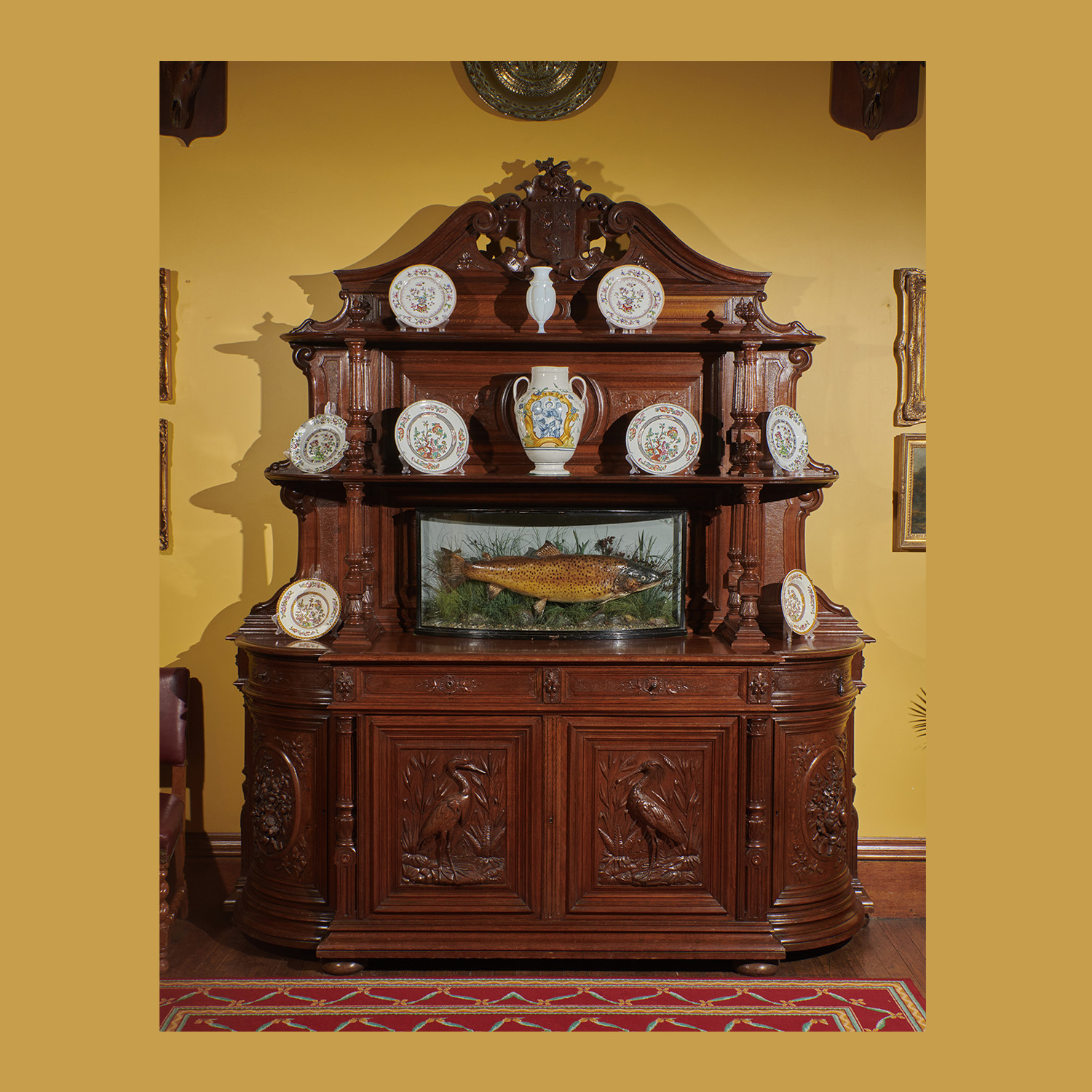
Mid-19th century oak sideboard bearing, at top, the Herbert family motto and crest. The Welsh Dragon, or Wyvern. is incorporated into the crest, which also bears the Welsh motto, ‘Pawb Yn Eu Arfer.’ This is translated as ‘Every man according to his taste.’
The doors on the lower front portion of the sideboard are decorated with protruding carvings of standing birds. The two curved doors on the corners are decorated with protruding floral carvings. Probably c. 1860 in date.
The brown trout displayed on all three sideboards in the Main Hall weigh between 6 and 7 kilograms (14 and 16 lbs). They were caught in the Lakes of Killarney by Mr Arthur Rose Vincent.

This is the smaller of the two Killarney Inlaid davenports, or writing desks, in this room. The substrate is of pine and mahogany, veneered with arbutus and yew.
The davenport is decorated with views of well-known Killarney tourist sights including Muckross Abbey, Ross Castle and Glena Cottage (destroyed 1920). Ferns decorate the writing slope, while the up-stand is decorated with an eagle, harp and deer, as well as trailing shamrocks. Probably mid to late 19th century in date.
Killarney Inlaid Furniture: A Brief History.
During the 1820s bog oak and bog yew, found in bogs close to Killarney town, began to be used to produce wooden goods for tourists. By the late 1830s the wood of the native arbutus (Arbutus unedo) was also being exploited to produce inlaid items. This industry was well established by the late 1840s.
Items of furniture produced by this inlaid arbutus industry included: cabinets, chiffoniers, davenports and games’ tables. Smaller items were also produced. The inlaid motifs included representations of local tourist sites including: Muckross House, Muckross Abbey, Killarney House, Glena Cottage, Ross Castle, Innisfallen, etc. Representations of the eagle, deer and Iris

This fine example of a Killarney inlaid table probably dates to the mid to late 19th century. The substrate is of mahogany, veneered in yew and arbutus.
The table is elliptical in shape and centrally decorated with sprays of Killarney Fern. The outer edge is decorated with well-known Killarney sights including: Muckross House, Muckross Abbey, Killarney House (demolished 1870s), Ross Castle, Glena Cottage (destroyed 1920), the Old Weir Bridge and Derrycunnihy. An inner band of inlay is composed of alternating ferns with the fruit and leaves of the arbutus (Arbutus unedo).
The bulbous central column and pedestal is decorated with the harp motif and shamrocks.
Killarney Inlaid Furniture: A Brief History.
During the 1820s bog oak and bog yew, found in bogs close to Killarney town, began to be used to produce wooden goods for tourists. By the late 1830s the wood of the native arbutus (Arbutus unedo) was also being exploited to produce inlaid items. This industry was well established by the late 1840s.
Items of furniture produced by this inlaid arbutus industry included: cabinets, chiffoniers, davenports and games’ tables. Smaller items were also produced. The inlaid motifs included representations of local tourist sites including: Muckross House, Muckross Abbey, Killarney House, Glena Cottage, Ross Castle, Innisfallen, etc. Representations of the eagle, deer and Iris

This richly decorated Killarney davenport, or writing desk, is probably mid to late 19th century in date. The writing slope is decorated with an image of Glena Cottage (destroyed 1920), flanked on either side by a Killarney Fern. Below, the two doors are decorated with images of Ross Castle (left) and Muckross Abbey (right).
The remainder of the davenport is richly decorated with a wide variety of motifs including shamrocks, oak leaves and acorns, rose sprays etc. There is also a depiction of an eagle (left side) and a harp (inside). The two dark wood uprights, or pillars, at front are decorated with shamrock carvings, with ferns at base.
Killarney Inlaid Furniture: A Brief History.
During the 1820s bog oak and bog yew, found in bogs close to Killarney town, began to be used to produce wooden goods for tourists. By the late 1830s the wood of the native arbutus (Arbutus unedo) was also being exploited to produce inlaid items. This industry was well established by the late 1840s.
Items of furniture produced by this inlaid arbutus industry included: cabinets, chiffoniers, davenports and games’ tables. Smaller items were also produced. The inlaid motifs included representations of local tourist sites including: Muckross House, Muckross Abbey, Killarney House, Glena Cottage, Ross Castle, Innisfallen, etc. Representations of the eagle, deer and Irish harp were also used, while decorative borders included shamrocks, ferns, oak leaves and acorns, roses, holly leaves, etc.
This Killarney industry was in decline by the 1880s. However, between 1929 and 1952 the production of inlaid arbutus furniture continued in the Gap of Dunloe. with.

The shelves hold a wide variety of reading materials relating to estate management and natural history. There are also encyclopaedias, Irish Senate records for the period 1922-1931, as well as some novels.
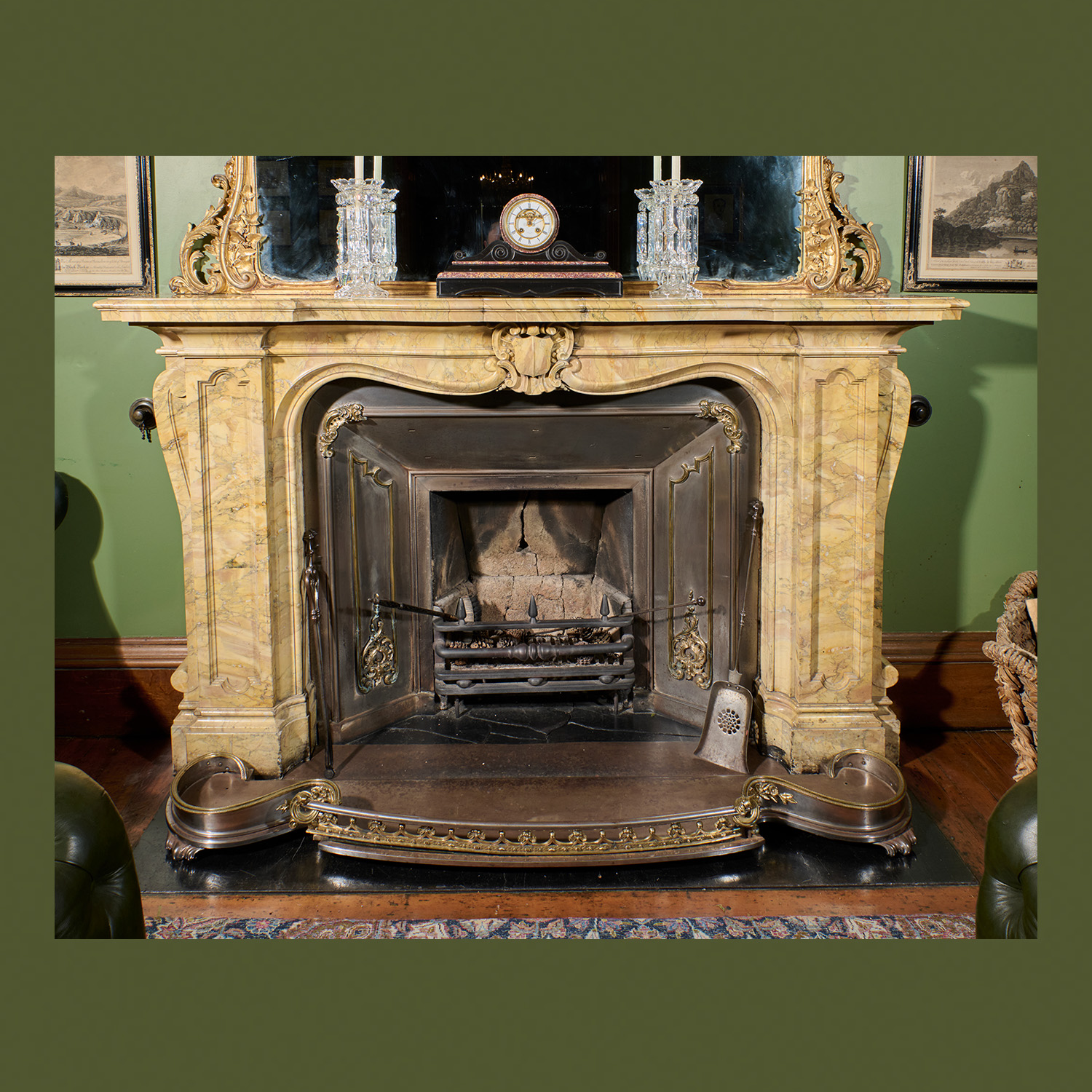
The chimney-surround is of Welsh marble, decorated with a central cartouche and ornamental scroll work. The fire inset is of iron with brass decoration.
The chimney-surround is surmounted by one of a pair of large over-mantle gilt mirrors. The second mirror is located in the Drawing Room.
A bell pull, to summon a servant, is located on either side of of the fireplace.

Italian marble chimney-surround, with central cartouche and ornamental scroll work. The fire inset is of iron with brass decoration.

There are two of these mahogany boxes, with fan-shaped marquetry, in the Dining room. They stand on the tables set to either side of the fireplace.The boxes were used to store, safeguard and transport silver cutlery and are possibly Georgian in date (c. 1714-1830).
One of the boxes still retains its fitted interior for holding pieces of cutlery and can accommodate a set of six table settings. The second box was, at some stage, altered and fitted to accommodate stationery.

This is one of two similar, but not identical, oak side tables, which stand in the window bays of the Dining Room. A third table of this type is located in the Library.
The tables are Neo-Renaissance in style and probably date to the mid-19th century. The decorative motifs include egg and dart mouldings, stylised leaves and animal heads. The tables also have bulbous legs and sleigh-type feet.
A Japanese Imari Urn stands on the table in the north window bay. The body is decorated with panels of flowering chrysanthemums and peonies; the shoulder has a raised band of chrysanthemums.
The urn probably dates to the late 17th or early 18th century. The carved and pierced wooden cover is later in date.

Similar in style to large sideboard at end of room.
The carvings on the doors are believed to depict Arts, Education and Industry.
Probably mid-19th century in date.

The sideboard is composed of several sections joined together, with loose carved parts attached to the up-stand.
The mirrors in the up-stand were intended to reflect light and to enhance the display of silverware.
The deep carving is neo-renaissance in style. The solid walnut gives way in places to walnut veneer on pine.
Believed to have been commissioned for the visit of the English Queen Victoria to Muckross in August 1861.
It bears the Herbert family crest of the Welsh Dragon or Wyvern.

Drop-in seats with woven horse-hair upholstery. The weft (left to right) of the latter is horse-hair, the warp (up and down) is cotton.
Probably early 19th century in date.

The table is fully collapsible, having a winding mechanism and drop-in leaves. When fully extended it measures 5.5 m in length. The legs are of elm.
The table probably dates to the early part of the 19th century.

Associated with the Vincent family seat of ‘Summerhill’ Clonlara, Co. Clare. The chairs are likely to have been brought to Muckross by Arthur Rose Vincent c. 1910, upon his marriage to Maud Bowers Bourn.
The two chairs, with their good quality, fantasy-style carvings, are similar but not identical. The square, claw feet hint at a possible Georgian-period date (c. 1714-1830).
Each arm rest terminates in a carved animal head. The uprights of the sloping backrest are decorated with a Vitruvian scroll-type decoration. At top a central bearded face with possible stylised head-dress, is flanked on either side by a winged, long-tailed dragon, or griffin.
The upholstery is of red and gold silk damask. It is held in place by relatively modern upholstery tacks and has a French-stitched edging. The stuffing is probably of horse hair.